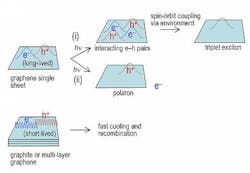Dispersed graphene makes excellent protective optical limiter
Singapore and Cambridge, England--A novel dispersion of graphene can serve as an excited-state optical absorber that, while it bleaches due to saturable absorption, has the ability to switch to an absorber well below the onset of microbubble or microplasma formation—providing highly effective broadband optical limiting of laser light.1 The dispersions, which are of single sheets of graphene spaced substantially apart in liquid cells or solid film matrices, were created by scientists at DSO National Laboratories, the National University of Singapore (NUS), and the University of Cambridge.
The dispersions are a great improvement over other forms of graphene—such as carbon black, nanotubes, few-layer graphenes, and graphene oxides—that also bleach due to saturable absorption but switch to optical limiting only at very high fluences due to microbubble or microplasma formation.
The researchers have developed a method to prevent the restacking of graphene sheets in fabrication by attaching alkyl surface chains to them, while still keeping the integrity of the nano-graphene pockets on the sheets. This method in turn produced a material that can be processed in a solution and dispersible into solvents and film matrices.
The dispersed graphenes exhibit a giant nonlinear optical-absorption response to intense nanosecond laser pulses over a wide spectral range with a threshold that is much lower than that found in carbon-black suspensions and carbon-nanotube suspensions, setting a new record in energy limiting onset of 10 mJ/cm2 for a linear transmittance of 70%.
These optical limiting materials can now be used for protection of sensitive sensors and devices from laser damage, and for optical circuits. They can be also used in anti-glare treated devices.
The principal investigator of the graphene team at DSO National Laboratories, Geok-Kieng Lim, who is also an adjunct professor at the NUS Department of Physics, says: "This is an important first step in the development of practical graphene nano-composite films for applications where the graphene sheets remain fully dispersed. The induced change in their non-linear optical behavior is amazing and highly practical."
REFERENCE:
1. Geok-Kieng Lim et al., Nature Photonics (2011); doi:10.1038/nphoton.2011.177

John Wallace | Senior Technical Editor (1998-2022)
John Wallace was with Laser Focus World for nearly 25 years, retiring in late June 2022. He obtained a bachelor's degree in mechanical engineering and physics at Rutgers University and a master's in optical engineering at the University of Rochester. Before becoming an editor, John worked as an engineer at RCA, Exxon, Eastman Kodak, and GCA Corporation.
